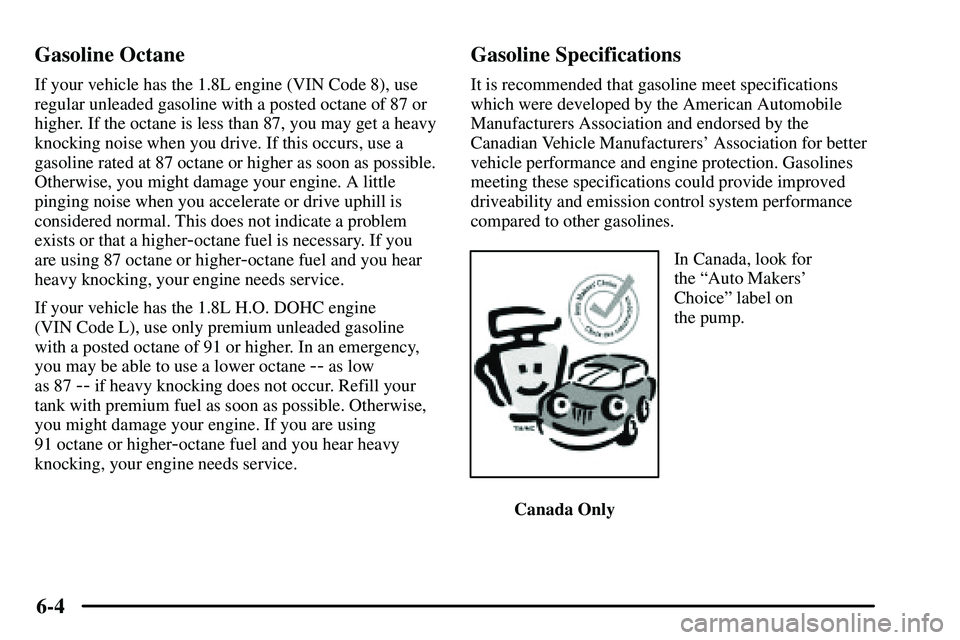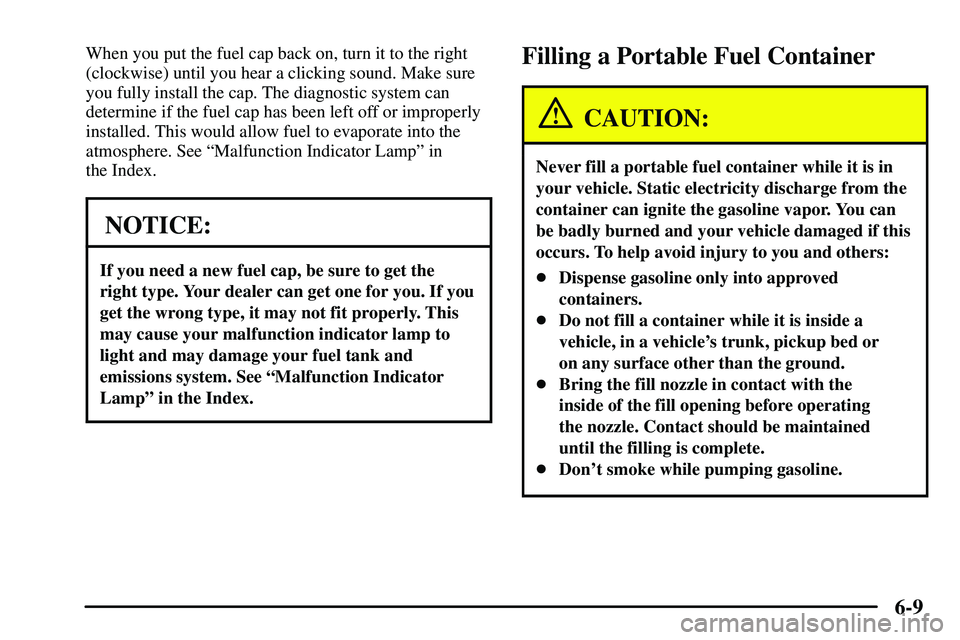Page 139 of 381
2-75
Here are five things some owners ask about. None of
these show a problem with your fuel gage.
�At the gas station, the fuel pump shuts off before the
gage reads F or full.
�It takes a little more or less fuel to fill up than the
gage indicated. For example, the gage may have
indicated the tank was half full, but it actually took
more or less than half the tank's capacity to fill it.
�It takes the gage several minutes to read F or full
after filling the vehicle with fuel.
�The gage moves a little when you turn, stop or
speed up.
�The gage doesn't go back to E or empty when you
turn off the ignition.Low Fuel Warning Light
This light comes on when
the fuel tank is low on fuel.
To turn it off, add fuel to the tank. See ªFuelº in
the Index.
Page 249 of 381

6-4 Gasoline Octane
If your vehicle has the 1.8L engine (VIN Code 8), use
regular unleaded gasoline with a posted octane of 87 or
higher. If the octane is less than 87, you may get a heavy
knocking noise when you drive. If this occurs, use a
gasoline rated at 87 octane or higher as soon as possible.
Otherwise, you might damage your engine. A little
pinging noise when you accelerate or drive uphill is
considered normal. This does not indicate a problem
exists or that a higher
-octane fuel is necessary. If you
are using 87 octane or higher
-octane fuel and you hear
heavy knocking, your engine needs service.
If your vehicle has the 1.8L H.O. DOHC engine
(VIN Code L), use only premium unleaded gasoline
with a posted octane of 91 or higher. In an emergency,
you may be able to use a lower octane
-- as low
as 87
-- if heavy knocking does not occur. Refill your
tank with premium fuel as soon as possible. Otherwise,
you might damage your engine. If you are using
91 octane or higher
-octane fuel and you hear heavy
knocking, your engine needs service.
Gasoline Specifications
It is recommended that gasoline meet specifications
which were developed by the American Automobile
Manufacturers Association and endorsed by the
Canadian Vehicle Manufacturers' Association for better
vehicle performance and engine protection. Gasolines
meeting these specifications could provide improved
driveability and emission control system performance
compared to other gasolines.
In Canada, look for
the ªAuto Makers'
Choiceº label on
the pump.
Canada Only
Page 254 of 381

6-9
When you put the fuel cap back on, turn it to the right
(clockwise) until you hear a clicking sound. Make sure
you fully install the cap. The diagnostic system can
determine if the fuel cap has been left off or improperly
installed. This would allow fuel to evaporate into the
atmosphere. See ªMalfunction Indicator Lampº in
the Index.
NOTICE:
If you need a new fuel cap, be sure to get the
right type. Your dealer can get one for you. If you
get the wrong type, it may not fit properly. This
may cause your malfunction indicator lamp to
light and may damage your fuel tank and
emissions system. See ªMalfunction Indicator
Lampº in the Index.
Filling a Portable Fuel Container
CAUTION:
Never fill a portable fuel container while it is in
your vehicle. Static electricity discharge from the
container can ignite the gasoline vapor. You can
be badly burned and your vehicle damaged if this
occurs. To help avoid injury to you and others:
�Dispense gasoline only into approved
containers.
�Do not fill a container while it is inside a
vehicle, in a vehicle's trunk, pickup bed or
on any surface other than the ground.
�Bring the fill nozzle in contact with the
inside of the fill opening before operating
the nozzle. Contact should be maintained
until the filling is complete.
�Don't smoke while pumping gasoline.